Resolve Orphaned Workspaces Tasks
This article shows how you can resolve the Orphaned Workspaces policy vulnerability when Syskit Point detects that Microsoft Teams and Microsoft 365 Groups don’t have active owners.
When a team no longer has an active owner, there is no longer a person on the other end of an automated governance policy which means the site could potentially have shared files that are outdated and pose a serious security risk.
When configuring the Orphaned Workspaces policy, Syskit Point Administrators can decide how the process of assigning owners to orphaned workspaces will look like. There are 3 options available:
- Specific users are asked to assign new owners
- A 1-stage process where the policy vulnerability is resolved when you promote members to owners or add new owners
- Existing team/group members receive a task to suggest new owners
- A 2-stage process where, after the members suggest new owners, an additional step is required from defined users to approve the suggestion
- Syskit Point automatically assigns new owners
- The last owner's manager is assigned as the new group owner
- In case the manager is not found, a defined user gets a task to resolve the vulnerability
In all cases, Syskit Point will send you an e-mail that will guide you through resolving the policy vulnerability, or notify you if you were assigned as a workspace owner.
Below, all cases are explained in more detail.
Specific Users Assign New Owners
Policy Vulnerability E-Mail
Syskit Point sends you an e-mail that includes all of the workspaces where the policy vulnerability was detected, asking you to assign new owners to Microsoft Teams or Microsoft 36 Groups that have no active owners assigned.
You can find the following information in the e-mail:
- Due date to resolve the policy vulnerability (1); you have 15 workdays to resolve the policy vulnerability
- Microsoft Teams or Microsoft 365 Group where the policy vulnerability was detected (2)
- Resolve button (3) that takes you to Syskit Point, where you can resolve the policy vulnerability
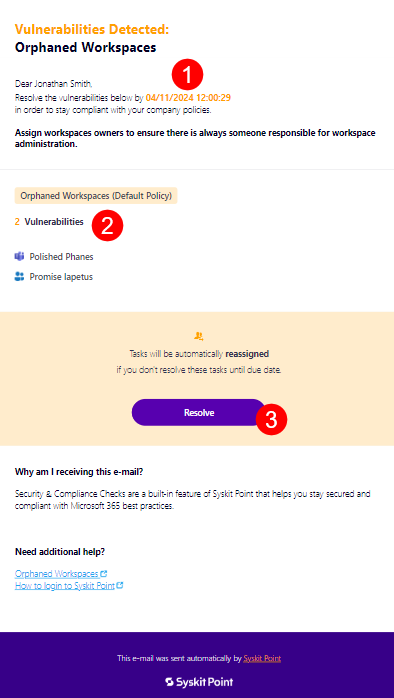
Policy Vulnerability Task
Along with the e-mail, Syskit Point creates a policy vulnerability task that provides you with all the information and actions needed to resolve the policy vulnerability. The following are available on the task screen if you were selected to assign new owners:
- List of current members along with Search to help you filter out specific ones (1)
- Promote to Owner action (2); once clicked, an appropriate message appears next to the promoted user along with the Undo action (3)
- Add New Owner action (4); to add a new owner, start typing the user's name in the input field; once you select a user, confirm your addition by clicking the Add New Owner link; once clicked, an appropriate message is displayed for the user, along with the Undo action (5)
- Archive button (6) that enables you to Archive the Microsoft Team or Microsoft 365 Group
- Delete button (7) that enables you to Delete the Microsoft Team or Microsoft 365 Group
- Resolve button (8) that gets enabled when you promote members to owners or add new ones to comply with the company policy; once clicked, a dialog opens, enabling you to input a comment and resolve the policy vulnerability
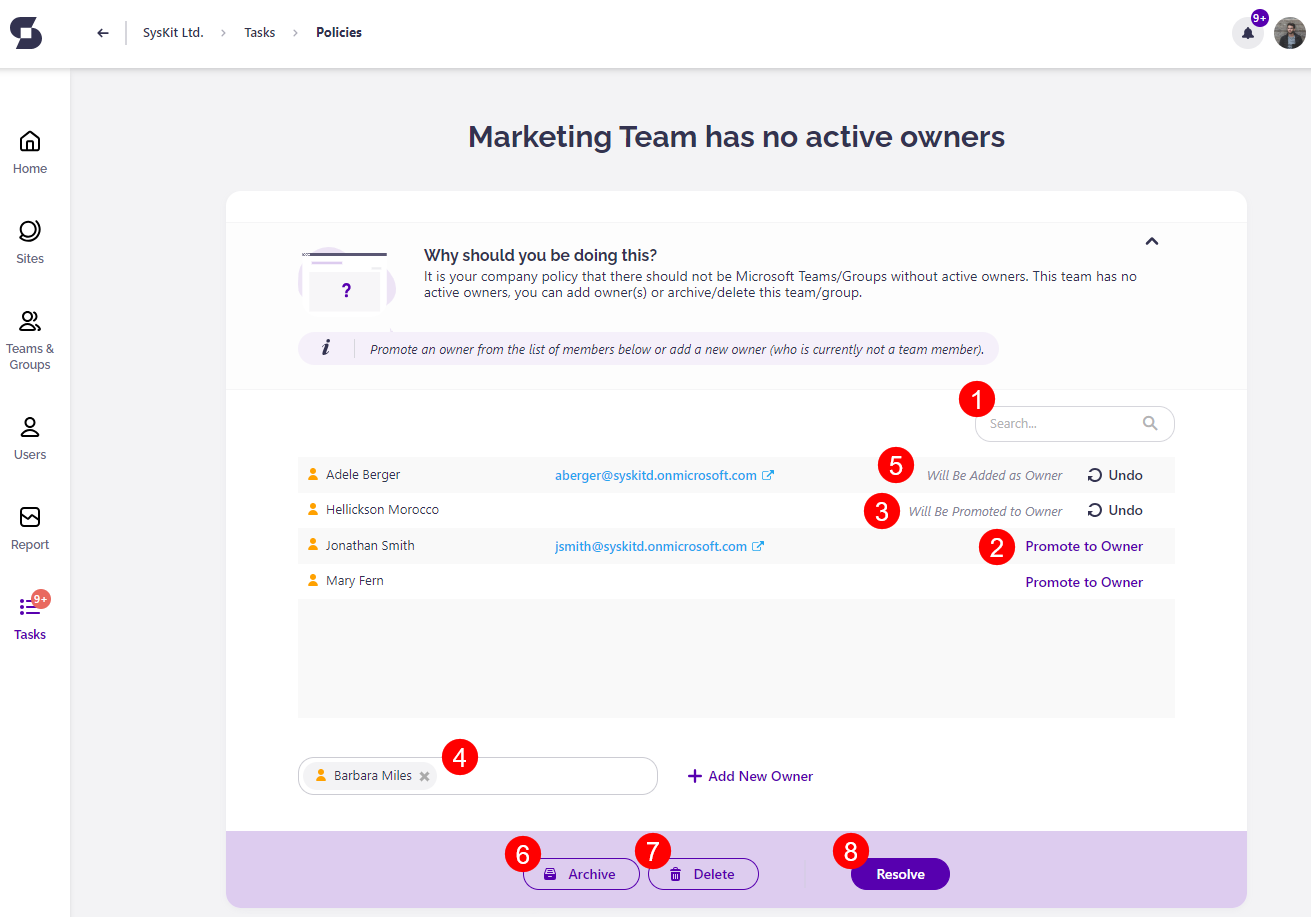
Please note! When you click an action within the policy vulnerability task, think of it as a preview of what will happen after resolving the policy vulnerability. All actions that change users' access are performed after you click the Resolve button.
Policy Vulnerability Resolved
After you resolve the policy vulnerability, the History screen opens, giving you an overview of all actions performed within the workflow.
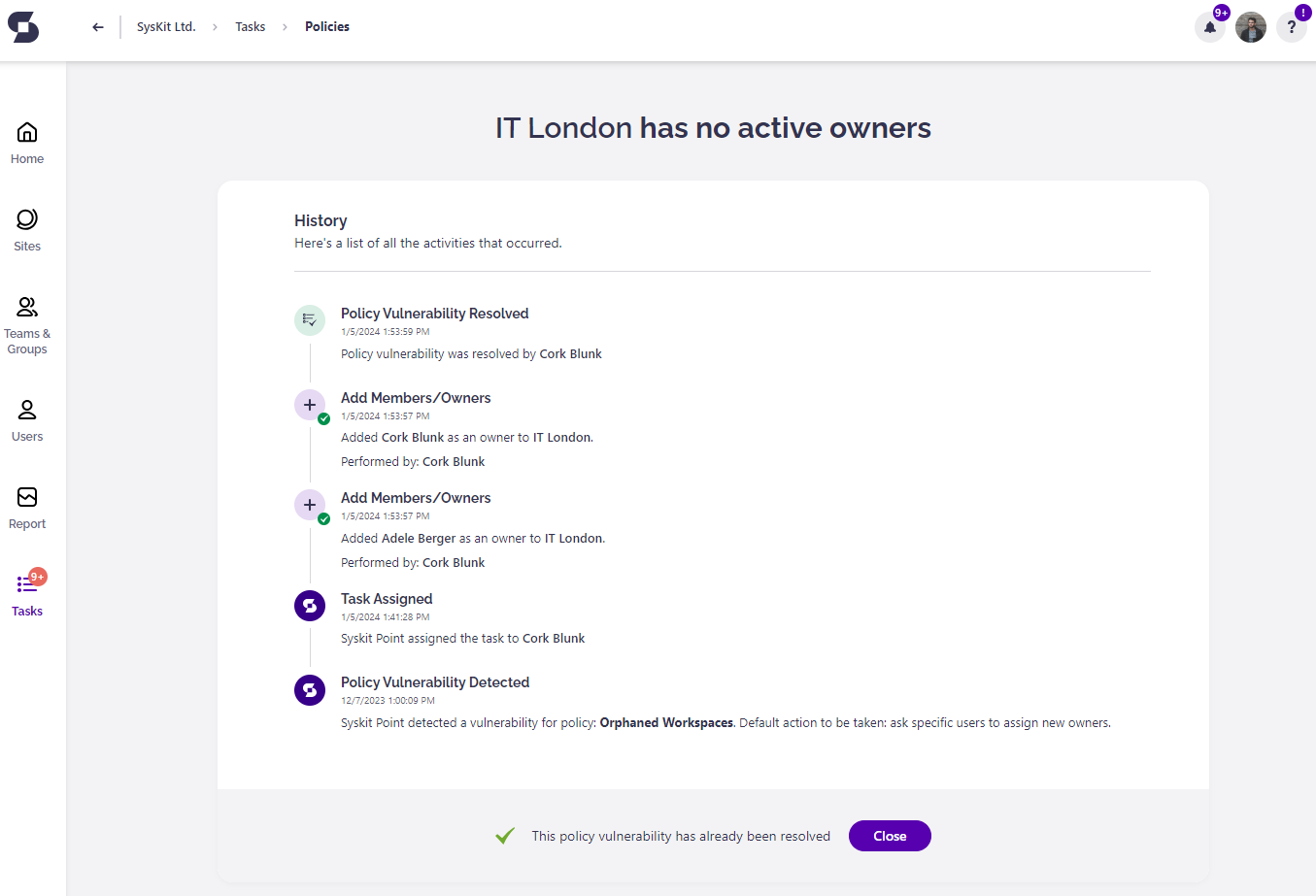
After you resolve the policy vulnerability, a confirmation e-mail is sent to all users that were assigned with the task, showing the following information:
- Microsoft Teams or Microsoft 365 Group where the policy vulnerability was resolved
- Who and when resolved the policy vulnerability
- View Details button that opens the History screen in Syskit Point showing all the activities that were performed within the workflow
Members Suggest New Owners
Members’ Policy Vulnerability E-Mail
In the first stage, if you are a member of the team/group that has no owners, you will receive an e-mail asking you to suggest new owners.
You can find the following information in the e-mail:
- Microsoft Teams or Microsoft 365 Group where the policy vulnerability was detected (1)
- Due date to resolve the policy vulnerability (2); you have 15 workdays to resolve the policy vulnerability
- Resolve button (3) that takes you to Syskit Point, where you can resolve the policy vulnerability

Click the Resolve button to open the policy vulnerability task in Syskit Point.
Members’ Policy Vulnerability Task
Along with the e-mail, Syskit Point creates a policy vulnerability task that provides you with all the information and actions needed to resolve it within Syskit Point. The following are available on the task screen:
- List of current members along with Search to help you filter out specific ones (1)
- Suggest action (2); once clicked, an appropriate message appears next to the suggested user along with the Undo action (3)
- Suggest New Owner action (4); to suggest a new owner, start typing the user's name in the input field; once you select a user, confirm your addition by clicking the Suggest New Owner link; once clicked, an appropriate message is displayed for the user, along with the Undo action
- Suggest Archive button (5) that enables you to suggest archiving the Microsoft Team or Microsoft 365 Group
- Suggest Delete button (6) that enables you to suggest deleting the Microsoft Team or Microsoft 365 Group
- Resolve button (7) that gets enabled when you suggest what to do with the team/group to comply with the company policy; once clicked, a dialog opens, enabling you to input a comment and resolve the policy vulnerability
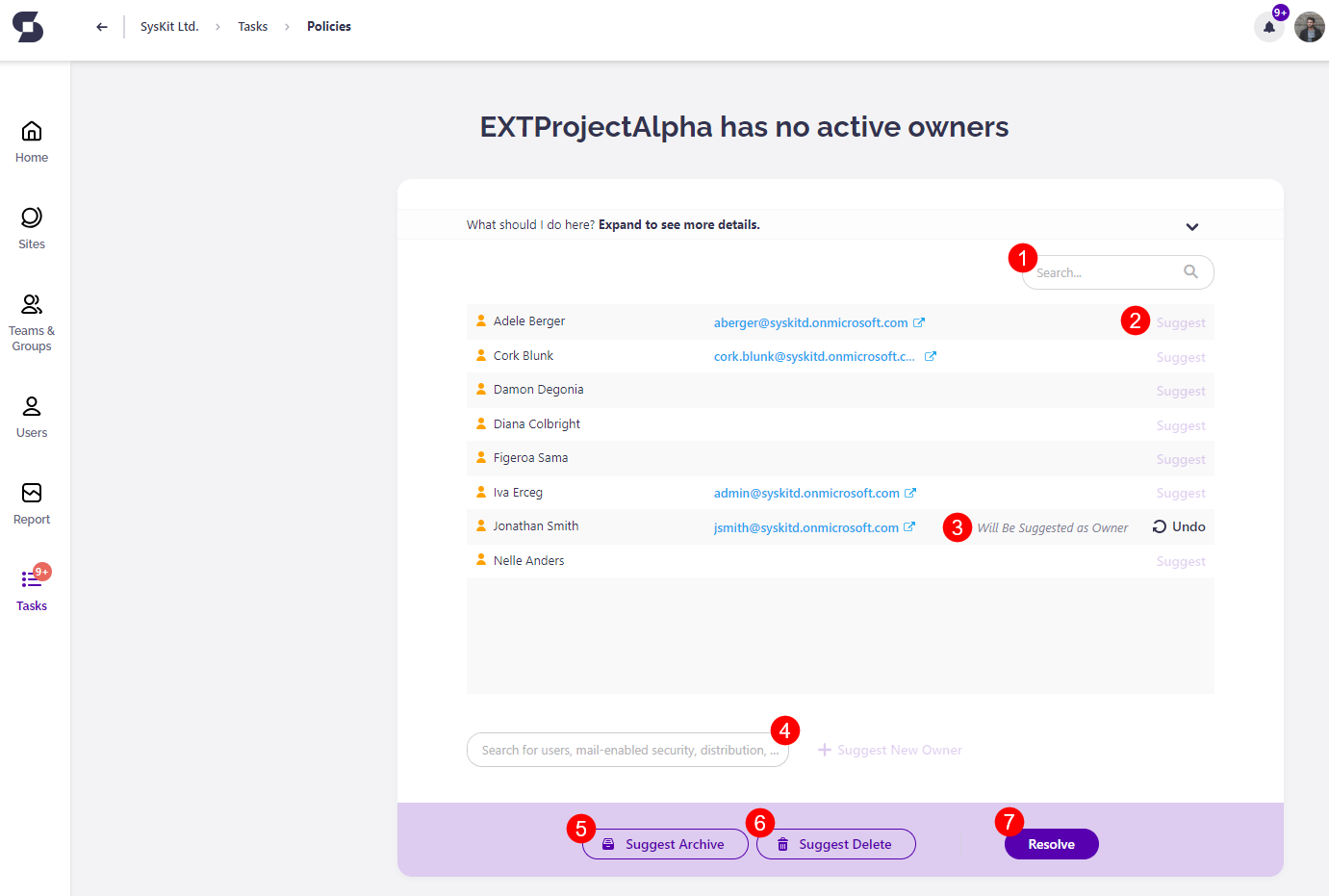
Please note! When you suggest a new owner or the team/group to be archived or deleted, your suggestion is forwarded to the approvers along with suggestions from other members. The approvers will finalize the actions and resolve the policy vulnerability based on the suggestions.
Members’ Policy Vulnerability Task Resolved
After you resolve your task, the History screen opens, giving you an overview of all actions performed within the workflow.

In the second stage of the process, if you are defined to approve members' suggestions for the team/group having no owners, you will receive an e-mail asking you to assign new owners and resolve the policy vulnerability.
Please note! You will receive the e-mail after all members suggest what to do with the team/group or the due date for the first stage is reached.
You can find the following information in the e-mail:
- Microsoft Teams or Microsoft 365 Group where the policy vulnerability was detected (1)
- Due date to resolve the policy vulnerability (2); you have 15 workdays to resolve the policy vulnerability
- Resolve button (3) that takes you to Syskit Point, where you can resolve the policy vulnerability
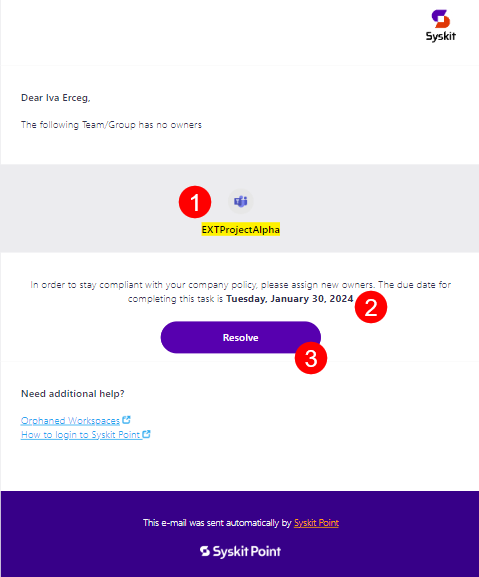
Click the Resolve button to open the policy vulnerability task in Syskit Point.
Approvers’ Policy vulnerability Task
Along with the e-mail, Syskit Point creates a policy vulnerability task that provides you with all the information and actions needed to resolve the policy vulnerability. The following are available on the task screen:
- Number of votes from members for each option (1)
- Promote to Owner action; once clicked, an appropriate message appears next to the promoted user along with the Undo action (2)
- Add New Owner action (3); to add a new owner, start typing the user's name in the input field; once you select a user, confirm your addition by clicking the Add New Owner link; once clicked, an appropriate message is displayed for the user, along with the Undo action
- Archive action (4) that enables you to archive the Microsoft Team or Microsoft 365 Group
- Delete action (5) that enables you to delete the Microsoft Team or Microsoft 365 Group
- Accept Risk Policy button (6) that enables you to disregard the company policy in case there is a valid reason to do so; if the risk is accepted, no further e-mails will be sent or tasks created for the number of days you select
- Resolve button (7) that gets enabled when you promote members to owners or add new ones to comply with the company policy; once clicked, a dialog opens, enabling you to input a comment and resolve the policy vulnerability

Policy Vulnerability Resolved
After you resolve the policy vulnerability, the History screen opens, giving you an overview of all actions performed within the workflow.
After you resolve the policy vulnerability, a confirmation e-mail is also sent to all users that were assigned with the task, showing the following information:
- Microsoft Teams or Microsoft 365 Group where the policy vulnerability was resolved
- Who and when resolved the policy vulnerability
- View Details button that opens the History screen in Syskit Point, showing all the activities that were performed within the workflow
Please note: The Orphaned Workspaces policy vulnerability is detected when there are 0 active owners assigned to a workspace.
If 1 owner is assigned to a workspace when resolving the Orphaned Workspaces vulnerability, Syskit Point will detect the Minimum Number of Owners policy vulnerability, as the default requirement is to have at least 2 owners per workspace.
Syskit Point Automatically Assigns New Owners
Automatically Assign New Owners
This option automatically assigns a new owner to an Orphaned Workspace.
Once a workspace is detected as without any active owners, the following situations are possible:
- When the owners of a workspace have been deleted or have blocked sign-in
- The manager of one of these disabled or deleted owners is assigned as the new owner.
- This can happen only if the manager is not deleted and does not have blocked sign-in.
- If there are two inactive owners and they both have an active manager, the role of workspace owner is assigned to the manager having the most recent sign-in date.
- An e-mail notification is sent to notify this user
- If the manager of the deleted user (or user with blocked sign-in), also has their sign-in blocked, had been deleted, or has not been recently active , the Orphaned Workspaces task is assigned to the specific resolver as defined when setting up the policy.
- An e-mail notification is sent to notify this user
- The manager of one of these disabled or deleted owners is assigned as the new owner.
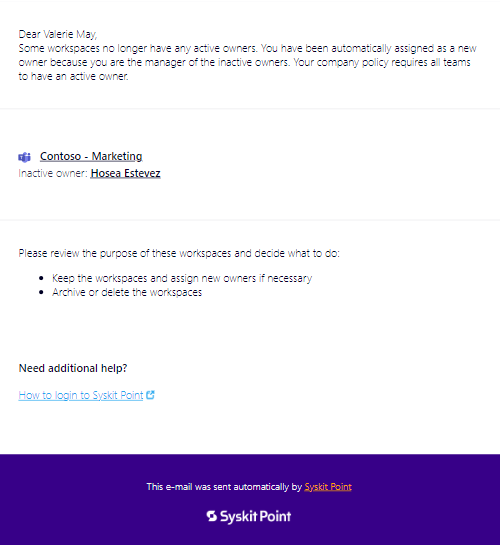
- If a new owner was located, however, the action of assigning them as the new owner of the workspace ends in failure, the task is assigned to Syskit Point Administrators.
- In this case, an e-mail notification is not sent to Syskit Point Administrators.
Please note: The Orphaned Workspaces policy vulnerability is detected when there are 0 active owners assigned to a workspace.
If 1 owner is assigned to a workspace when resolving the Orphaned Workspaces vulnerability, Syskit Point will detect the Minimum Number of Owners policy vulnerability, as the default requirement is to have at least 2 owners per workspace.